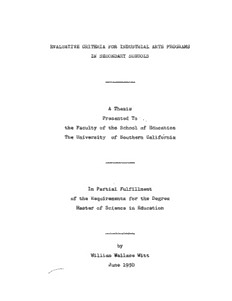
Evaluative criteria for industrial arts programs in secondary schools PDF
Preview Evaluative criteria for industrial arts programs in secondary schools
EVALUATIVE CRITERIA FOR INDUSTRIAL ARTS PROGRAMS IN SECONDARY SCHOOLS A Thesis Presented To the Faculty of the School of Education The University of Southern California In Partial Fulfillment of the Requirements for the Degree Master of Science in Education by William Wallace Witt June 1950 UMI Number: EP56165 All rights reserved INFORMATION TO ALL USERS The quality of this reproduction is dependent upon the quality of the copy submitted. In the unlikely event that the author did not send a complete manuscript and there are missing pages, these will be noted. Also, if material had to be removed, a note will indicate the deletion. Dissertation Publishing UMI EP56165 Published by ProQuest LLC (2014). Copyright in the Dissertation held by the Author. Microform Edition © ProQuest LLC. All rights reserved. This work is protected against unauthorized copying under Title 17, United States Code ProQuest LLC. 789 East Eisenhower Parkway P.O. Box 1346 Ann Arbor, Ml 48106-1346 £ ^ JS~0 LA) HU This thesisj written under the direction of the Chairman of the candidateJs Guidance Committee and approved by all members of the Committee, has been presented to and accepted by the Faculty of the School of Education of the University of Southern California in partial fulfillment of the requirements for the degree of Master of Science in Education. Dean Guidance Committee Chairman ___ TABLE OF CONTENTS PART I ORIENTATION OF STUDY CHAPTER PAGE I. THE PROBLEM...................... 1 The problem............................. 2 Statement of the problem............ 2 Limitation of the problem............. . 2 Importance of the study . . . . . . . . 3 Definitions of terms used 7 Industrial arts • • • • . . • • • • • • 7 Organization ............ 7 Subjectivity . . . 7 Objectivity .......................... 7 Methodology .................... 7 II. REVIEW OF LITERATURE AND ORGANIZATION OF REMAINDER OF THESIS.................... 9 Review of literature .................. 9 Organization of remainder of thesis . . . 13 PART II DEVELOPMENT OF CRITERIA III. ORGANIZATION . . . . . .................. 15 Administration of Program .......... 15 Student enrollment .................. 15 iii CHAPTER PAGE Grouping of students in courses . • . • 19 Time allotment............... 20 Teaching load • .................... 21 Records • • • • ................. 22 Administrative participants .......... 24 Administration of course .............. 24 Student management • • • • • • . . • • 25 Reference facilities . . .......... 27 Student planning facilities .......... 29 Display facilities .................. 31 IV. THE CURRICULUM.......................... 33 Industrial arts department......... . . 33 Basic philosophy and objectives . . . . 33 How instructional areas are taught • • 3# Curriculum revision.................. 43 Industrial arts courses ........ 44 Course objectives ♦ ........ . . . . . 44 Course planning ........... 47 The safety program.................. 51 Pupil evaluation......... 56 V. THE TEACHER..................... 60 The teacher in his c l a s s .............. 60 Student interest and participation • • 6l Developing student ability .......... 63 iv CHAPTER PAGE Conducting student experiences . . . . . 64 The teacher in his profession .......... 68 VI. THE PLANT AMD EQUIPMENT . .............. 72 Location and size of p l a n t .......... 73 Lighting........................... . . 75 Ventilation............. 73 Painting • . • ........................ 81 Equipment........* .................. 8 3 Electricity.......................... 86 Lavatory facilities ...................... 88 Acoustics ...................... . . . . . 38 Storage facilities . . . . . ............ 89 PART III A CHECKLIST FOR EVALUATION VII. THE CHECKLIST........................... .. 94 The original checklist .................. 96 Jurors1 rating of the checklist .......... 103 Question two in Part I, A .............. 103 Question six in Part II, B ........ 106 Question six in Part I V .................. 107 Question eight in Part IV . . . . . . . . . 107 Other discrepancies in the ratings . . . . 108 The revised checklist .................... 120 V CHAPTER PAGE Answers to the checklist................ 12$ PART IV CONCLUSIONS VIII. CONCLUSIONS................................ 133 BIBLIOGRAPHY........................................135 LIST OF TABLES TABLE PAGE I. Number and Percentage of Jurors Rating Respective Checklist Questions Necessary, Helpful, and Of Little Value............. 104 II* Comparison of the Numbers of Teachers and Supervisors Rating Respective Checklist Questions Necessary, Helpful, and Of Little Value . ............ . . . . . . . . 109 III* Comparison According to Population of the Numbers of Jurors Rating Respective Checklist Questions Necessary, Helpful, and of Little Value............... * 114 IV. Comparison According to Geographic. Location of the Numbers of Jurors Rating Respective Checklist Questions Necessary, Helpful, and of Little Value .................... 117 PART I ORIENTATION OF STUDY CHAPTER I THE PROBLEM One of the most important processes being conducted in our schools today is that of evaluation,. If it is objective in nature and carefully arrived at, it can per form major constructive functions in the betterment of the school program, ,fIt can provide a periodical check which gives direction to the continued improvement of the pro gram of the school or college; it can help to validate some of the important hypotheses upon which the program operates; it can furnish data about individual students essential to wise guidance; it can give a more satisfactory foundation for psychological security of the staff, of parents, and of students; and it can help both teachers and pupils to clarify their goals."I In order to achieve these functions, the evaluative program must be planned and instituted with thought. The two areas in which planned evaluation is a necess ity are the areas of educational environment and educational outcome. The former consists of all things within the school which influence the student; the latter is the degree to which the student has matured through their influence. 1 R. W. Tyler, "A General Statement of Evaluation," Journal of Educational Research. XXX {March, 1942), 492.
